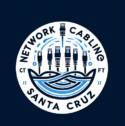What Are the Three Main Parts of a Cable? Understanding Cable Structure and Function
If you’ve ever wondered what the three main parts of a cable are, you’re not alone. Whether you’re dealing with electrical wiring, Ethernet cables, or fiber optics, every cable shares the same basic structure designed to protect and transmit signals efficiently. Understanding these parts helps you choose the right type of cable for your home, office, or commercial project — and ensures safe, reliable connections. Our structured cabling experts in Santa Cruz ensure every component of your network cable is installed and tested for optimal performance.
The Three Main Parts of a Cable
All cables, regardless of their type or use, are built around three essential components:
- Conductor
- Insulation
- Sheath (or Jacket)
Each of these plays a crucial role in how a cable carries power or data while staying safe and efficient. Let’s take a closer look at how they work together.
1. The Conductor – The Core Path for Electricity or Data
The conductor is the heart of any cable. It’s the material that allows electrical current or data signals to flow from one end to another.
Common materials include:
- Copper: The most common choice for electrical and Ethernet cables due to its excellent conductivity and flexibility.
- Aluminum: Often used in power cables for long-distance transmission where weight and cost are factors.
- Fiber optics: Instead of metal, these use thin glass or plastic strands to transmit light signals at extremely high speeds.
The quality and size of the conductor determine how efficiently current or data flows — and how much power or bandwidth the cable can handle.
2. The Insulation – Protection for the Core
The insulation is the layer that surrounds the conductor. Its main purpose is to prevent short circuits, electrical leakage, and signal interference. It keeps the electrical or data flow contained within the cable and prevents contact with other conductors or surfaces.
Common insulation materials include:
- PVC (Polyvinyl Chloride): Affordable, flexible, and used in most home and office cables.
- PE (Polyethylene): Offers better moisture resistance and is common in outdoor or underground cables.
- Teflon (PTFE): Used in high-performance applications due to its resistance to heat and chemicals.
Insulation not only ensures safety but also plays a big role in maintaining signal quality — especially in high-speed data cables like CAT6 or CAT6a Ethernet cables.
3. The Sheath (or Jacket) – The Outer Shield
The sheath, also known as the jacket, is the outermost protective layer of the cable. It shields the internal parts from physical damage, UV light, chemicals, and moisture.
In addition to protection, the sheath also provides structural strength, allowing the cable to be pulled, bent, or handled during installation without damaging the inner components.
Types of cable jackets include:
- PVC Jackets: Standard for indoor cables.
- LSZH (Low Smoke Zero Halogen): Used in buildings where fire safety is a concern — it produces minimal smoke and no toxic gas.
- Armored Jackets: Used for industrial or outdoor environments where extra protection is needed.
The sheath is what you see and touch — but inside, it’s working hard to protect everything that makes your cable function properly.
Why Knowing Cable Parts Matters
Understanding the three main parts of a cable isn’t just technical knowledge — it’s practical. Here’s why it matters:
- Safety: Prevents improper installations that could cause short circuits or fire hazards.
- Performance: Helps you choose the right type of cable for your speed or power needs.
- Durability: Knowing the right jacket or insulation ensures your cable lasts longer in its environment.
Whether you’re installing network cabling in California, wiring a home theater, or setting up a data center, knowing how a cable is built can save you time, money, and maintenance headaches later. Each part of a cable plays a specific role depending on the type of network it supports — learn more about the four types of networks and how they function.
Different Types of Cables and Their Applications
Depending on the application, the materials and construction of these three parts vary:
- Electrical cables: Use copper or aluminum conductors with thick insulation for power distribution.
- Data cables (like CAT6): Use twisted copper pairs with precision insulation to minimize interference.
- Fiber optic cables: Use glass fibers as conductors with cladding and buffer coatings for data transmission via light.
- Coaxial cables: Have an additional metallic shield between the insulation and outer jacket to prevent signal loss.
Each cable type builds on the same three-part foundation — just with materials and designs optimized for its specific purpose.
Choosing the Right Cable for Your Needs
When selecting a cable, always consider:
- Environment: Indoor, outdoor, or underground?
- Application: Power, data, or audio/video?
- Performance: Speed, bandwidth, or voltage capacity?
- Safety standards: Local codes like the California Building Code (Title 24) or fire rating requirements.
If you’re unsure, consult a professional low-voltage or structured cabling expert who can recommend the right materials and handle installation safely. Cable length also impacts performance — find out what the longest network cable you can use without losing signal quality.
Conclusion
The three main parts of a cable — conductor, insulation, and sheath — work together to ensure reliable performance and safety. Whether it’s for internet connectivity, electrical power, or communication systems, every high-quality cable relies on this same essential structure.
By understanding how cables are made and what materials are used, you can make better choices for your home, business, or industrial projects — ensuring long-lasting, dependable connections.
